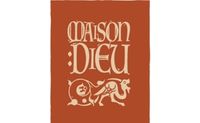Architect and designer William Burges's work represents the High Victorian Dream at its most dazzling.
The Mayor's Parlour in the Town Hall he designed in Dover ranks among his best work.
'Hospitality for all strangers'
Maison Dieu (meaning House of God) began as a monastery around 1200, offering 'hospitality for all strangers', chiefly pilgrims travelling to Canterbury Cathedral to visit the shrine of Thomas Becket. The site has passed through many uses over the centuries, until 1834 when it was bought by Dover Corporation to be Dover's Town Hall. The Corporation set about converting Maison Dieu for public and civic use, and in 1859 brought in architects William Burges and Ambrose Poynter to restore the ancient fabric and convert it for its new role. The site's more ancient past still breathes through the re-purposed spaces, for example the chapel that became a courtroom, or the Stone Hall that became a council chamber.
More jewel-like than architecture
It was William Burges who chiefly effected this transformation. He was an inspired choice: as he announced himself, 'I have been brought up in the 13th century belief, and in that belief I intend to die’ (meaning his belief in its style –Burges was not religious himself). Maison Dieu was Burges’s only civic commission and takes its place alongside his better known buildings like Castell Coch, Cardiff Castle and Mount Stuart on the Isle of Bute. At Maison Dieu, he incorporated a law court, prison cells, a fine assembly hall and sumptuous new mayoral quarters. Public and civic spaces alike were embellished by his distinctive and colourful decorative schemes, and he also designed the fixtures and fittings, many of which remain. In one corner of the complex, the Mayor’s Parlour Block was among the richest of these interiors.
A new use for one of Burges’s finest interiors
Dover District Council (DDC) has now initiated an ambitious £8.5m project at Maison Dieu, including support from the National Heritage Lottery Fund, to restore the whole complex and bring it back into vibrant use. Working with DCC and their architects, Landmark is delighted to have been asked to provide an end use for The Mayor’s Parlour Block, set in one corner of the upper ground floor with a private staircase to further rooms above. Burges’s full decorative schemes will be recovered in the main rooms of this block, which still has many of his original fittings. This will be a unique chance to experience living in rooms designed by this architectural master of the High Victorian period and a must for anyone captivated by the Gothic Revival – or simply wanting to explore the wonders of Dover Castle and its White Cliffs.
Maison Dieu: Inside the Mayor's Parlour Webinar
Find out more about conserving Victorian architect and designer William Burges’ Neo-gothic decorative scheme for our forthcoming holiday let in the heart of Dover. The webinar includes contributions from Martin Crowther from the Maison Dieu, Alastair Dick-Cleland from The Landmark Trust and Tom Organ from Arte Conservation.
In partnership with



Dover's Town Hall has always been known as Maison Dieu (meaning House of God). It began life in 1203 as a monastic hostel, practising 'hospitality for all strangers' and especially for pilgrims travelling from the Continent to Canterbury Cathedral to visit the shrine of Thomas Becket. Signs of this very ancient past can still be read in today's complex: for example, in the 13th-century chapel later converted to a courtroom. Later used as a hospital and then a naval victualing yard, the grouping was bought in 1834 by the Corporation of Dover for use as a town hall.
The Corporation set about converting Maison Dieu for public use, and in 1859, brought in architects William Burges and Ambrose Poynter to restore the ancient fabric and convert it for its new civic use.
Burges received a copy of A W Pugin’s book Contrasts from his father for his fourteenth birthday, and it was a prophetic gift. His biographer J. Mordaunt Crook assessed Burges as 'the most dazzling exponent of the High Victorian Dream.' Pugin conceived that dream; Rossetti and Burne-Jones painted it; Tennyson sang its glories; Ruskin and Morris formulated its philosophy; but only Burges built it.’
Burges's faith in that dream sings out at Maison Dieu, the only civic commission among his better known buildings like Castell Coch, Cardiff Castle and Mountstewart on the Isle of Bute. At Maison Dieu, he incorporated a law court, prison cells, a fine assembly hall and sumptuous new mayoral rooms. Burges’s distinctive decorative schemes ran rampant across public and civic spaces alike, complemented by his own fixtures and fittings, many of which remain. In one corner of the complex, the Mayor’s Parlour and Magistrate’s Office behind were among the richest of these interiors, conceived by Burges as the equivalent of the privy chambers of an important royal functionary at a medieval court: high coffered ceilings, flamboyant decorative scheme and tall, hooded stone fireplaces. It was used by the Mayor for receptions and important meetings. Sadly Burges died in 1881, and it fell to his brother-in-law, architect Richard Popplewell Pullen, to see the decoration through to completion.
Now owned by Dover District Council (DDC), a huge conservation deficit built up and Maison Dieu became increasingly run down. Today's council offices are on a business park outside the town, but Maison Dieu remains an architectural jewel in the centre of Dover. DDC has now initiated an £8.5m project with enabling support from the National Heritage Lottery Fund to restore and revitalise the whole complex. The Mayor’s Parlour has no obvious use in today’s scheme. Its enjoyment as a Landmark not only gives it a new and purposeful use as a holiday let but also will enable a degree of wider public access on open days, so that Burges’s High Victorian dream can be appreciated by all.
Working closely with architects Haverstock LLP, a new Landmark will be created that takes the Mayor’s Parlour as its dining room, around the original Burges-designed table. The equally sumptuous Magistrates’ Office behind will act as kitchen and living space. A private staircase, with views across an internal Gothic court, will lead to well-proportioned two double bedrooms and bathrooms on the floor above.
The suite will have its own access from the street and is set at one corner of the Maison Dieu, at the opposite end from the public areas of the site. The rest is to become a new visitor attraction, which Landmarkers will of course be able to explore too.